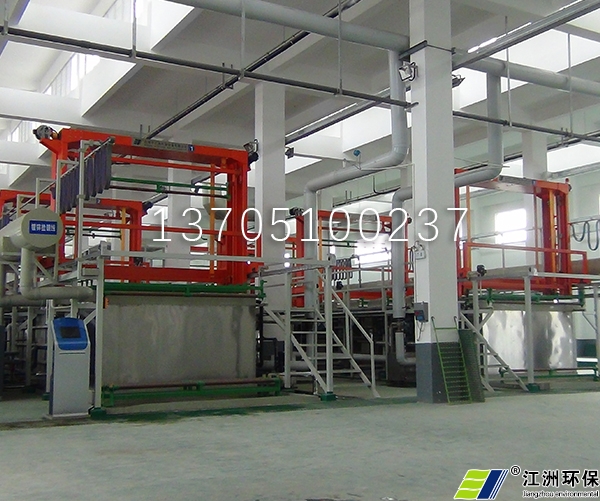Electroplating equipment What are the components of?
The following is an explanation of the structure of general continuous plating terminal plating equipment:
1. Solution tank body: common materials include PP, PVC and stainless steel. VC tank can be used without heating, PP tank can be used if the temperature is lower than 70 ℃, and stainless steel tank can be used if the temperature is higher than 70 ℃, but stainless steel tank (metal tank) cannot be used for electroplating process tank. In the continuous electroplating process, there are denominator slots and sub slots. The mother tank is used to hold the liquid medicine in the electroplating process, while the child tank is used in the electroplating process. Currently, there are three ways of denominator slot separation, integration and sharing. The design scheme of the main tank structure is relatively pure, and only factors such as water flow, mixing, steady flow, positioning, anode and cathode distance need to be considered.
2. Tank body underframe: generally plastic tank derivative frame, angle iron, stainless steel square tube, black iron coating, etc. In order to consider the compressive strength and corrosion resistance, it is recommended to use stainless steel square tubes.
3. Water inlet system: generally pure water and tap water are used. Each medicine tank and water tank has a water inlet, which is used to replenish the water level and clean the water tank. In order to avoid pipeline leakage or human negligence, the electroplating process tank is not equipped with water inlet device.
4. Drainage system: general drainage system needs to be classified before setting drainage system. Wastewater is divided into acid, alkali, nickel, gold, tin and lead, etc. Moreover, it is recommended to use more than one inch of pipe for the drainage pipe of each tank. The drainage effect is better. The common washing tank is equipped with a single drain valve, while each electroplating process tank is equipped with a double drain valve to avoid the accidental discharge of liquid medicine. Each sink is provided with an overflow pipe to avoid full water flowing into its sink.

5. Air extraction system: the electroplating equipment needs to be sealed (i.e., the upper cover) to have air extraction effect. An air intake port is arranged in the medicine tank which mainly produces waste gas, and the air intake amount can be adjusted. Due to the extremely high moisture content in the gas, a drainage device is required. The extracted gas must also be treated with waste gas.
6. Electric heating system: the heating system is very important because the medicine tank needs to be heated. General heating system consists of heater, temperature sensor, liquid level sensor, temperature setter, TIMER, alarm, etc. Due to safety problems, it is necessary to equip a waterless automatic power-off system. The material soaked in the liquid medicine is long in titanium metal, but stainless steel or Teflon is recommended.
7. Cooling system: Generally, there are direct freezing and indirect freezing. The direct freezing method is to pump the liquid medicine into freezer Cooling, good freezing effect. The indirect freezing method is to discharge the indirect freezing liquid medicine from the cooling water pipe into the medicine tank. The freezing effect is poor and it is difficult to clean. The cooling methods of the refrigerator include water cooling (cooling tower must be provided) and air cooling (fan). If the tin lead solution can be kept at a low temperature for 24 hours, the solution will not cause turbidity.
8. Electrical control system: In addition to the above electrical control of heating and cooling systems, there are also electrical controls of pumps, filters, oscillators, rectifiers, actuators, ovens, blowers, etc., which are usually summarized and controlled by the power control box. The rectifier and drive are set as interlocks.
9. Wiping equipment: among continuous electroplating equipment, there are rubber scraper, brush, air blowing, absorbent sponge and other wiping methods. The blowing effect is good, but the cost is high. At present, there are air compressor generation and blower generation. The terminal with poor structure (easy to deform) is not suitable for brush and scraper, and the silicon rubber scraper is suitable for flat terminal.
10. Drying system: after electroplating, the water drops on the terminal surface must be removed, or the drying effect will be poor. Generally, the oven for drying is HEATER or IR, which is dried under hot air circulation. The oven requires temperature control.
11. Feeding system: the general feeding methods are horizontal and vertical. The feeding area is equipped with a paper winding device, which is connected with a switch and positions the guide wheel. If the production speed is fast, buffer wiring should be set.
12. Feeding system: the general feeding methods are horizontal and vertical. The feeding area should be equipped with transmission devices (some special transmission devices are not in the feeding system), counting devices, linkage switches, feeding devices, paper turntables, positioning guide wheels, and buffer wiring should be set when the production speed is high.
13. Pump filter: generally divided into horizontal pump and vertical pump, and its specifications are distinguished by HP horsepower. The higher the horsepower, the greater the flow. The larger the amount, the smaller the number of particles that can be filtered, and the better the filtering effect. Generally speaking, gold bath and nickel bath shall be used for 1, and others shall be used for 5. They shall be checked regularly every week. The longer the filtering time is, the better the effect will be. The 24-hour filtering is good.
14. Rectifiers: currently, there are silicon controlled rectifiers, crystal rectifiers, frequency conversion rectifiers, pulse rectifiers, etc. Because DC waviness will affect the range of current density, the smaller the filtering degree, the wider the operable current density, and the filtering degree is generally below 3%. Among them, the frequency converter rectifier is good, and the filtering degree is about 0.1%.
15. Positioner: Generally, the methods used for medicine tank are fixed (used when fully immersed) and adjustable (used when choosing coating or considering current distribution), and the materials used are acid and alkali resistant, heat-resistant plastic, glass, ceramics, etc. Most locators outside the tank are made of stainless steel.
16. Cathode and anode: the specification of cathode (anode) wire is working current/4 * (number of wires). If the current is 100 amps and there are two conductors, the cross-section of the conductor should be at least 12.5 mm2. Anodes are divided into dissolved anode and insoluble anode. Dissolution anode is used for supplement (common in ordinary metal electroplating process), while insoluble anode is used for auxiliary anode. For example, nickel is used as dissolution anode in nickel plating, and titanium basket is used to hold nickel, so it is insoluble anode. Precious metal electroplating process generally uses insoluble anode with good conductivity. Precious metal insoluble anode (such as platinum) can be used. The cathode generally refers to the plating piece, but the cathode mentioned here is the cathode guide for conducting the plating piece. Generally, the cathode conductive head is made of copper alloy or stainless steel. The material can only be determined by considering the conductivity, corrosion resistance, operation and cost. Moreover, the contact between the cathode conductive head and the plated part is better, and the smaller the friction is, the better.
17. Agitator: in order to improve the efficiency of the electroplating process, improve the uniformity of the electroplating process, and improve the current density, the mixing effect must be strengthened. Generally, strong water flow mixing, cathode oscillation mixing, ultrasonic mixing, air mixing and other methods are used.







